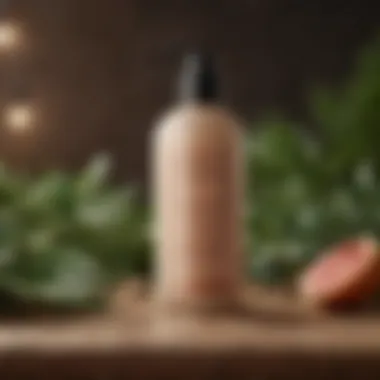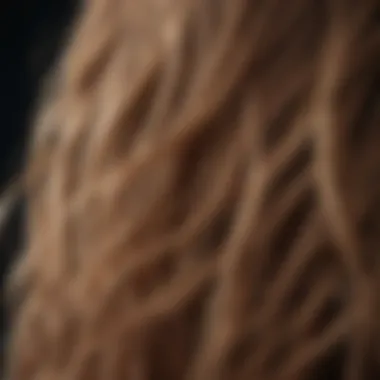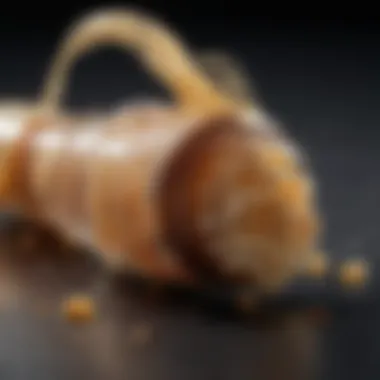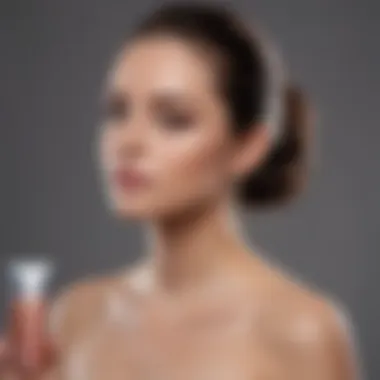Leave-in Conditioners for Dry, Brittle Hair


Intro
Leave-in conditioners are essential for addressing dry, brittle hair. Understanding hair care products is critical for maintaining healthy locks. This section explores what makes leave-in conditioners effective. For many people, dry hair poses a significant challenge. Factors such as weather, heat styling, and chemical treatments contribute to hair damage. A leave-in conditioner offers a solution.
The primary function of a leave-in conditioner is to provide moisture and protection throughout the day. Unlike traditional conditioners, they do not require rinsing. This continuous application can significantly improve the texture and appearance of hair over time. Choosing the right leave-in conditioner requires awareness of specific needs, such as hair type and individual concerns.
In this comprehensive guide, we will analyze the causes of dry hair, the benefits of incorporating leave-in conditioners into your regimen, and techniques for proper application. Additionally, we highlight key ingredients that can enhance hair health. Understanding these elements empowers readers to make informed choices about their hair care routines.
Prologue to Leave-in Conditioners
Leave-in conditioners play a crucial role in the hair care routine, especially for those with dry and brittle hair. Unlike traditional rinse-out conditioners, leave-in products are designed to remain in the hair, providing continuous benefits throughout the day. They are effective moisture replenishes that work to combat dryness, improve hair texture, and enhance the overall appearance of hair.
In assessing the relevance of leave-in conditioners, it is significant to understand their formulation and how they differ from other hair products. These conditioners often contain a mix of moisturizing agents, oils, and proteins to nourish the hair from within. These compounds help seal moisture into the hair shaft and create a protective barrier against environmental damage.
Furthermore, with the increasing prevalence of hair damage from various sources, the importance of using leave-in conditioners cannot be overstated. They not only provide immediate relief for dry hair but also contribute to long-term hair health.
Defining Leave-in Conditioners
Leave-in conditioners are specialized products formulated to be applied to the hair after washing and conditioning. Unlike regular conditioners, these products do not require rinsing. Typically, they are lightweight creams or sprays designed to penetrate the hair shaft and deliver moisture without weighing hair down.
Most leave-in conditioners include a blend of ingredients that may contain water, humectants, natural oils, and proteins. Their purpose is twofold: to hydrate the hair and protect it from damage. They can be used on various types of hair, including straight, wavy, curly, or coily textures.
Purpose and Importance
The purpose of leave-in conditioners extends beyond mere hydration. They are essential for enhancing manageability, reducing frizz, and facilitating easier styling. When applied correctly, leave-in conditioners can help detangle hair, thereby minimizing breakage and split ends. This is particularly beneficial for those suffering from dry and brittle hair, where mechanical damage is a common issue.
Moreover, leave-in conditioners serve as protective agents against environmental factors such as UV rays, pollution, and humidity. They can also help in maintaining hair health when using heat styling tools. By incorporating a leave-in conditioner into your hair care routine, you provide not only immediate benefits but also foster long-term resilience against damage.
Understanding Dry and Brittle Hair
Understanding dry and brittle hair is crucial in the context of selecting effective leave-in conditioners. Dryness and brittleness can stem from various factors, leading to hair that is not only hard to manage but also prone to damage. By knowing the underlying causes and recognizing the symptoms, one can make informed choices about products that can help restore hair health.
Common Causes of Hair Damage
Environmental Factors
Environmental factors play a significant role in hair health. Conditions such as dry climates, exposure to sunlight, and pollution can strip hair of its moisture. The key aspect of environmental damage is the cumulative effect, where prolonged exposure leads to visible deterioration of hair quality. This element is crucial for this article since acknowledging these factors helps in choosing conditioners that include protective ingredients. The primary advantage of addressing environmental factors lies in preventive care, as simple changes, like wearing a hat or using protective styling products, can mitigate damage.
Chemical Treatments
Chemical treatments are one of the leading causes of hair brittleness. Processes like coloring, perming, and straightening can alter the hair structure, resulting in loss of natural oils and hydration. A notable characteristic of chemical treatments is their immediate effect: while they can provide short-term aesthetic results, long-term consequences often involve weakened strands. This is vital for readers who may frequently use such treatments, as it underscores the importance of incorporating leave-in conditioners that target and repair damage from previous chemical applications.
Heat Styling Tools
Heat styling tools, such as flat irons and curling wands, are known for causing significant hair damage. Prolonged or excessive heat can lead to cuticle damage, resulting in splits and breakage. The key takeaway about heat styling is the direct relationship between temperature and hair health. This aspect makes it beneficial to discuss in this article, as readers can recognize their styling habits and consider the necessity of moisture-rich leave-in conditioners to combat the damage. The unique feature of heat damage is that it can often be minimized or prevented through the use of protective sprays or creams prior to styling, which enhances the overall health of the hair.
Health Conditions
Health conditions can also contribute to hair dryness and brittleness. Issues such as hormonal imbalances, nutritional deficiencies, or underlying medical conditions can affect hair’s moisture levels. The key characteristic of these health conditions is that they may not be immediately apparent as hair-related issues. Thus, including this topic in the article is important, as it highlights that beyond topical solutions, some readers may need to address broader health factors for complete hair restoration. The unique advantage of recognizing health conditions lies in the potential for holistic approaches, integrating dietary changes or treatments that enhance overall well-being along with leave-in conditioner usage.
Identifying Signs of Dry Hair
Identifying the signs of dry hair is the next step in understanding how to effectively treat it. Common indicators include brittleness, a lack of shine, and increased tangling. Recognizing these signs can help guide readers towards selecting appropriate leave-in conditioners that provide the necessary moisture and protection for their hair type.
Benefits of Using Leave-in Conditioners
Using leave-in conditioners specifically aids in mitigating issues associated with dry and brittle hair. This section elucidates the unique advantages these products provide and how they can significantly enhance hair health. Not only do they serve as an additional layer of moisture, but they also facilitate improved manageability and protection against various stressors.


Moisture Retention
One primary benefit of leave-in conditioners is their ability to retain moisture in the hair. Dry hair often results from a lack of hydration. Leave-in conditioners work to combat this by providing sustained moisture throughout the day. Designed with various formulations, many of these products contain humectants which draw moisture from the environment into the hair strands. Products featuring glycerin or aloe vera are common examples.
This moisture retention is vital. When hair maintains adequate moisture levels, it appears healthier, more vibrant, and is less likely to break or split. Regular use of a leave-in conditioner might lead to a noticeable change in hair texture over time, resulting in softer and more manageable locks.
Enhancing Manageability
Another significant aspect of leave-in conditioners is their role in enhancing the manageability of hair. For individuals with dry and brittle hair, daily styling can become difficult due to tangles and frizz. Leave-in conditioners can alleviate this challenge. When applied correctly, these products offer slip, making hair easier to comb through, thereby reducing the risk of breakage during styling.
This characteristic is particularly useful for those with textured or curly hair, which tends to be more prone to tangling. Utilizing a leave-in conditioner can allow for painless styling and improved results when using heat tools or during braiding. As a result, it empowers users to create various hairstyles without the worry of causing further damage.
Protection from Environmental Damage
Exposure to environmental factors—such as sun, pollution, and harsh weather—can exacerbate the condition of already dry hair. Leave-in conditioners provide an added layer of protection against these damaging elements. Many of these products have protective properties that can shield hair from UV rays and pollutants.
Furthermore, the right formulation can create a barrier, helping to prevent moisture loss caused by dry air or wind. Keratin and silicone are common ingredients found in many leave-in conditioners that can help protect the hair cuticle from damage. As a result, holidays, outdoor activities, or even regular commutes can be less stressful for hair when using a leave-in conditioner.
"Leave-in conditioners are not just beneficial but essential for those struggling with dry hair issues."
In summary, the benefits of using leave-in conditioners can significantly contribute to healthier hair. Moisture retention ensures hydration is locked in, managability allows for more effortless styling, and environmental protection helps maintain hair integrity. These aspects make leave-in conditioners a powerful tool in any hair care regimen aimed at addressing dryness and brittleness.
Choosing the Right Leave-in Conditioner
Selecting the appropriate leave-in conditioner is crucial for anyone dealing with dry, brittle hair. The right product can significantly impact hair hydration, manageability, and overall health. It is not merely a cosmetic choice; it is integral to maintaining the structure and appearance of hair. Consumers should consider several factors to find a leave-in conditioner that aligns with their unique hair needs.
Factors to Consider
Hair Type and Texture
Understanding your hair type and texture is vital in choosing a leave-in conditioner. Each hair type, whether straight, wavy, curly, or coily, has specific characteristics that affect how it responds to products. For example, fine hair may become weighed down by heavy formulations, while thicker hair may require richer products for adequate moisture.
The key characteristic to note is porosity. High-porosity hair often absorbs moisture quickly but loses it just as easily. Medium-porosity hair holds moisture reasonably well, while low-porosity hair can be resistant to moisture absorption. Choosing a leave-in based on this factor can make a difference, as it caters to how well your hair can take in and retain the product.
Ingredient Preferences
Ingredient preferences are another aspect of choosing a leave-in conditioner. Many consumers may opt for natural ingredients over synthetic ones due to allergies or environmental concerns. Natural oils like coconut or jojoba are beneficial for nourishing and moisturizing dry hair without the buildup often associated with synthetic ingredients.
An important feature is the absence of harsh chemicals such as sulfates and parabens. This is particularly relevant for individuals committed to maintaining healthy hair. While natural ingredients generally have fewer side effects, some synthetic ingredients may provide targeted benefits, so balance is important.
Formulation Types
The formulation type can greatly influence the effectiveness of a leave-in conditioner. These products come in various forms, such as sprays, creams, and oils. Each type has its benefits, with sprays being lightweight and easy to apply, making them a popular choice among those with fine hair. Creams may provide more intense hydration, suitable for thick or coarse hair that requires more moisture.
A unique aspect of formulation types is their capacity for layering. For instance, those with thicker hair may use a cream followed by an oil for added moisture. Understanding these distinctions helps in selecting a regimen that enhances the health of your hair while addressing dryness.
Top Ingredients for Dry Hair
Humectants
Humectants are vital ingredients for leave-in conditioners targeting dry hair. These compounds attract moisture from the environment into the hair, promoting hydration. Ingredients like glycerin and aloe vera are well-known humectants that are often included in formulations.
A notable feature of humectants is their ability to provide long-lasting moisture. However, in dry or low-humidity climates, they may draw moisture away from the hair instead of into it, which can lead to more dryness. Therefore, it's essential to balance their use with occlusive agents that lock moisture in.
Natural Oils
Natural oils serve as powerful allies in the quest for healthy hair. Oils like argan, olive, and sweet almond not only provide moisture but also form a protective barrier around the hair shaft. This can help in retaining hydration and preventing damage.


The appeal of natural oils lies in their versatility. They suit different hair types and can be used on their own or mixed with leave-ins. Yet, one should consider that oils can lead to buildup if used excessively, which may weigh down hair, especially if it is fine.
Proteins
Proteins help reinforce the hair structure, making them a popular choice in leave-in conditioners for dry strands. Ingredients like keratin and silk protein are recognized for their ability to rebuild and strengthen weakened hair. However, care must be taken not to overuse protein-based products, as this can lead to brittleness and breakage.
Proteins serve a dual purpose; they can improve manageability while also adding shine. Still, individuals should look for balance in their regimen to ensure natural moisture isn't compromised.
Silicones
Silicones create a protective coating around hair, which helps in shielding it from environmental damage and reducing frizz. Common silicones found in leave-in conditioners include dimethicone and cyclopentasiloxane.
While silicones are effective at providing a slick, smooth finish, they can sometimes lead to buildup on hair if not used correctly. Regular cleansing with a clarifying shampoo may be necessary to prevent this issue. Understanding how silicones work can help users make informed decisions about their hair care products.
"The right leave-in conditioner not only addresses dryness but also promotes long-term hair health by using suitable ingredients and accommodating individual preferences."
By carefully considering hair type, ingredient features, and formulation types, one can effectively choose a leave-in conditioner that fulfills the specific needs of dry, brittle hair. This informed choice is the foundation of nurturing healthy, resilient strands.
How to Apply Leave-in Conditioners
Applying leave-in conditioners correctly is key to maximizing their benefits for dry and brittle hair. Using these products in the right way ensures effective hydration and protection. Knowing how to apply them can transform your hair care routine and lead to noticeable improvements in hair health.
Application Techniques
For Damp Hair
Applying leave-in conditioner to damp hair is one of the most effective methods. This technique benefits from the moisture already in the hair. When hair is damp, it is more receptive to products, allowing the conditioner to penetrate deeply. This can lead to improved moisture retention.
The key characteristic of this method lies in its hydrating properties. By applying the product on damp strands, it seals in the moisture, which is crucial for dry hair. One unique feature of applying on damp hair is that it can help to detangle without causing breakage. However, it is important to avoid saturating the hair with too much product, as it may lead to weighing it down.
For Dry Hair
Applying leave-in conditioner to dry hair is also a viable option. This technique can provide an instant boost of moisture and can be great for touch-ups throughout the day. When applied directly to dry hair, the product can smooth out frizz and enhance shine almost immediately.
The key characteristic of this method is its quick, on-the-go application. It allows for revitalizing hair that looks parched without needing to rewet it. One unique feature is that it can help to refresh curls and waves by adding definition. However, it is essential to use a lightweight formula to prevent greasiness or heaviness, which can occur if too much product is used.
Distribution Methods
Effective distribution of leave-in conditioner is crucial to achieving even coverage. Applying the product with the right methods enhances its performance and ensures that every strand benefits. Common distribution methods include using fingers, a wide-tooth comb, or a spray nozzle.
Using fingers allows for precise application and can help to distribute the product evenly. A wide-tooth comb helps to detangle while distributing the conditioner. Spray nozzles provide a quick and even mist. Each distribution method has its benefits. Using fingers may lead to a more targeted application, while a comb can make hair look sleeker. However, it is essential to handle the hair gently to avoid causing additional breakage.
Frequency of Use
The frequency of using leave-in conditioners greatly impacts their effectiveness. Typically, these products can be used daily or several times a week, depending on individual hair needs. Monitoring how your hair responds to regular use is essential in determining the right schedule.
If your hair feels weighed down or greasy, consider reducing the application frequency or amount of product used. On the other hand, if the hair appears to remain dry, you may opt to increase the frequency. Understanding your specific needs is crucial for optimal results.
Incorporating Leave-in Conditioners in Your Hair Care Routine
Integrating leave-in conditioners into your hair care regimen is essential, especially for dry and brittle hair. Leave-in conditioners offer moisture and protection, acting as a barrier against damage and aiding in the restoration process. Consistent use embeds nourishing elements into the hair strands, making it vital for maintaining health and vitality.
Building a Comprehensive Hair Care Regimen
Shampooing
Shampooing is the first step in any hair care routine. A pivotal aspect focuses on cleansing the scalp and strands, removing dirt, excess oil, and product buildup. The key characteristic of shampooing is that it determines the starting point for hair health. A gentle, sulfate-free shampoo can prevent further drying out of already brittle hair, making it a beneficial choice. Its unique feature lies in its ability to prepare the hair to absorb conditioning treatments effectively.


However, one disadvantage can be over-washing, which can strip natural oils. Balancing shampoo use with the right products is crucial to achieve optimal cleanliness without compromising moisture retention.
Conditioning
Conditioning follows shampooing and is crucial for enhancing moisture levels. This step nourishes the hair, helping to detangle and improve manageability. The key characteristic of conditioning is the replenishment of moisture lost during washing. A good conditioner for dry hair often contains emollients that smooth the hair cuticle. This method is beneficial as it provides immediate softness and shine.
However, one must consider the need for effective rinsing. Sometimes, heavy conditioners can leave residue and weigh hair down. It is essential to choose a conditioner that meets your hair's specific needs for optimal performance.
Weekly Treatments
Weekly treatments serve as an intensive method to restore and repair hair. This aspect typically involves deep conditioning masks or treatments that provide extra moisture and nourishment. The characteristic of these treatments is their ability to penetrate deeper into the hair shaft, repairing damage at the molecular level.
Their unique feature lies in their concentrated formulas rich in essential nutrients. Using treatments weekly is beneficial for maintaining the resilience of dry hair, but they can be time-consuming. Careful selection of treatments ensures they complement the everyday hair care routine without becoming cumbersome.
Monitoring Results and Adjusting Accordingly
Monitoring results is vital in this process. It helps in assessing the effectiveness of your routine and determining when adjustments are necessary. Observing changes over time enables you to tweak products or techniques for better outcomes. Regular evaluations can guide your choice of leave-in conditioners, ensuring they align with evolving hair needs. Reassessing the condition of your hair allows for ongoing adjustments that contribute to long-term health.
Comparing Popular Leave-in Conditioners
When navigating the myriad options available, understanding the landscape of leave-in conditioners is essential for selecting the appropriate product for dry, brittle hair. This section will elucidate the imperative nature of comparing popular leave-in conditioners by exploring their specific features, benefits, and how they cater to various individual needs. In a market filled with choices, knowing the distinctions between brands and formulations can influence one’s hair care routine significantly.
Overview of Leading Brands
In the realm of hair care, several brands have established themselves as leaders, particularly in the category of leave-in conditioners. Olaplex, for instance, is renowned for its innovative approach to hair repair with formulations aimed at restoring the health of severely damaged hair. Their leave-in products often contain bonding technology that appeals to consumers with severely weakened hair.
SheaMoisture offers a selection focused on natural ingredients. Their leave-in conditioners typically feature rich elements such as shea butter and coconut oil, which are beneficial for moisture retention and improving texture. On the other hand, It's a 10 focuses on multiple benefits in one product. Their leave-in conditioner is popular for its ability to detangle, add shine, and protect against heat, making it a versatile choice for various hair types.
Understanding these brands and what they stand for helps consumers make informed choices aligning with their hair's specific needs. Each brand emphasizes unique ingredients and benefits, catering to the diverse requirements of individuals plagued by dry hair.
Consumer Insights and Reviews
Consumer experiences provide valuable insight into the effectiveness of leave-in conditioners. Many users tend to look at reviews on platforms like Reddit and Facebook, discussing their personal results with various brands.
For example, many users praise Olaplex's leave-in products for significantly improving hair texture and reducing breakage. Comments frequently highlight how consistent use results in smoother, healthier-looking hair. Conversely, SheaMoisture products are often noted for their rich, creamy textur, and how this provides a deep moisture boost, especially for users with curly or coily hair.
When evaluating consumer insights, specific aspects tend to arise:
- Effectiveness: Users frequently mention the immediate change in manageability post-application.
- Fragrance: The scent of a product can impact user enjoyment, with some reviews specifically commending pleasant and long-lasting fragrances.
- Price: The cost of these leave-in conditioners also comes into focus, with consumers often weighing effectiveness against price points.
Overall, analyzing how fellow consumers perceive these products adds an essential layer to understanding practical performance, which cannot typically be gauged by brand claims alone. Opting for leave-in conditioners based on both brand reputation and consumer feedback can guide individuals toward achieving healthier hair.
Ending: The Road to Healthy Hair
In this article, the journey towards healthy hair has been explored in detail. Leave-in conditioners play a pivotal role, especially for individuals dealing with dry and brittle hair. Their ability to provide moisture, improve manageability, and protect hair from environmental damage cannot be overstated. It is essential to understand how to integrate them into a sustainable hair care routine.
A comprehensive approach to hair health is essential. This goes beyond using leave-in conditioners. It involves a thorough analysis of personal hair needs, ongoing evaluation of product effectiveness, and adapting hair care practices.
Long-term Strategies for Hair Health
Long-term strategies form the backbone of maintaining hair health. First, establishing a consistent routine is crucial. Regular washing, conditioning, and the application of leave-in products create a foundation for well-nourished hair.
Additionally, consider the following strategies:
- Choose Quality Products: Invest in reputable brands known for effective formulations. Research ingredients that suit your hair type.
- Protect Against Damage: Utilize heat protection products when styling. Limit exposure to harsh weather conditions.
- Stay Hydrated: Maintaining hydration aids hair health. Hydration from within reflects externally. Drink sufficient water daily.
- Balanced Diet: A diet rich in vitamins and proteins supports hair growth. Nutrients like biotin, zinc, and omega-3 fatty acids are beneficial.
Emphasizing Consistency and Protection
Consistency is key in any hair care regimen. Incorporating leave-in conditioners consistently helps establish a protective barrier for hair. This assures that moisture is locked in and environmental damage minimized.
It is also vital to observe the following:
- Regular Application: Use leave-in conditioners after every wash. This permits hair to absorb nutrients effectively without buildup.
- Adjust as Needed: Pay attention to your hair's response. If dryness persists, reassess product types and application frequency.



